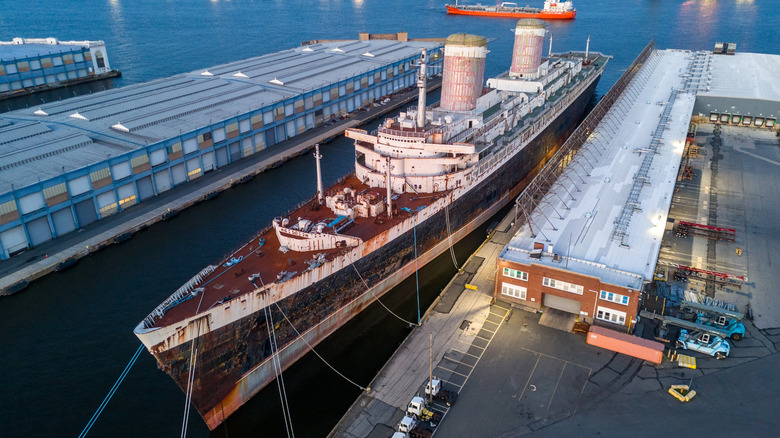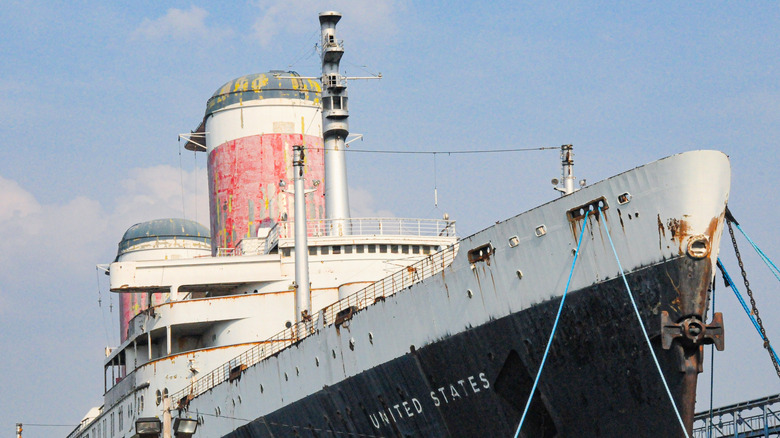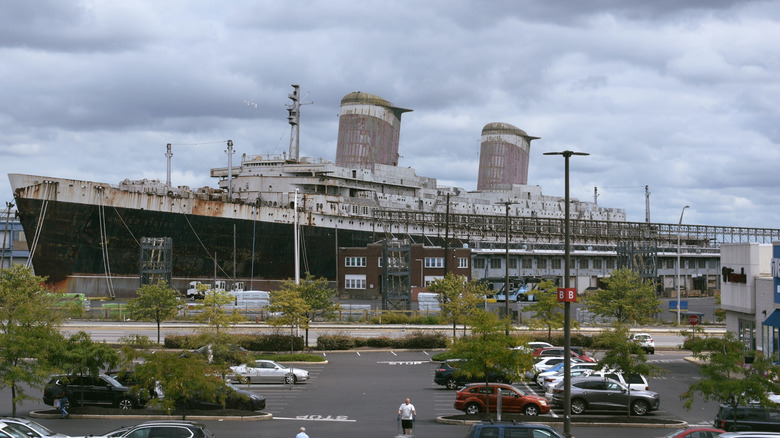All About The SS United States: Why Was This Ship So Important?
The SS United States, though reminiscent of Britain's iconic RMS Titanic, proudly showcased American ingenuity. Built from components sourced from each of the 50 states, the ocean liner stood as a testament to the nation's unity following World War II. The SS United States Conservancy says, "The SS United States represents our common values, our strengths, and the epic scope and scale of our ambition."
What really set it apart from other ocean liners, though, were its military capabilities. Construction of the SS United States was a joint venture between United States Lines and the U.S. government to make it both a top-of-the-line ocean liner and secret troop transport. The ship could transform from luxurious transport for A-list celebrities such as Marlon Brando, Coco Chanel, Sean Connery, and Judy Garland to carrying troops on short notice. When converted, it could hold 14,000 soldiers and travel 10,000 miles without refueling. It was 990 feet long – nearly as long as New York's Chrysler building is tall — so there was no shortage of space for those troops.
Thanks to how fast the SS United States could travel, the troops could reach their destination in no time. The engines in the SS United States propelled it up to 44 miles per hour, faster than today's U.S. Navy aircraft carriers. It went on to receive the Blue Riband, an award for the fastest transatlantic ocean liner.
The SS United States gave immigrants a new life
The SS United States took its maiden voyage in July 1952 and remains the largest passenger ship ever built in the U.S., 100 feet bigger than the Titanic. Unlike the Titanic, the United States — nicknamed the Big U — crossed the Atlantic 800 times before it was retired in 1969, when transatlantic travel via airplane was booming. Throughout its tenure, it transported celebrities and dignitaries, including U.S. presidents Harry Truman, Dwight Eisenhower, John Kennedy and Bill Clinton. It wasn't just for the wealthy, however — it also carried immigrants in search of a new life.
Renate Koerner journeyed on the Big U from Bremerhaven, Germany, to New York City in 1961. She was pregnant at the time and fought intense seasickness the entire trek, telling USA Today she stayed on her cabin until they docked in New York. The parents of 70-year-old Stephen Kosciesza jumped on the SS United States in 1954 and never looked back, emigrating from Britain. Seasickness must have been a common occurrence on the ocean liner because Kosciesza reminisced about his father's experience with the New York Times, saying, "The famous family story is that all the way over, he was saying, 'Commodore, stop the ship! I'm getting out.'"
But those times are long over. Today, the Big U is in Mobile, Alabama, where government officials are overseeing the removal of hazardous materials, including its fuel, preparing the ship for its final voyage.
A museum and the largest artificial reef
After the Alabama work is complete, the SS United States will be towed by a tugboat strong enough to tow massive ships to a site near Destin-Fort Walton Beach, on the Gulf Coast in Florida's panhandle. There it will be sunk in 180-foot-deep water with its highest level 60 feet below the surface, becoming the world's largest artificial reef. It will be home to a variety of marine life, including snappers, urchins, and crabs, making it a good diving spot. It will also be in good company with other sunken vessels, such as the USS Oriskany aircraft carrier, now a reef off the coast of Pensacola.
The SS United States Conservancy had wanted to keep the Big U afloat and looked for alternative berths after it was evicted from Pier 82 in Philadelphia in 2024, but the ship is too large. Every option available was either too shallow or too difficult to reach. The Inactive Ship Office, the agency responsible when a ship is "stricken" from the U.S. Navy, tried to be accommodating, but it also had no space for such a large ship.
While the United States now will only be accessible to divers, tourists without scuba certification will be able to learn about it on land. The Conservancy made a deal with Florida's Okaloosa County that included both the ship's intentional sinking and the construction of a land-based museum that will incorporate salvaged pieces from it, including one of its funnels.


